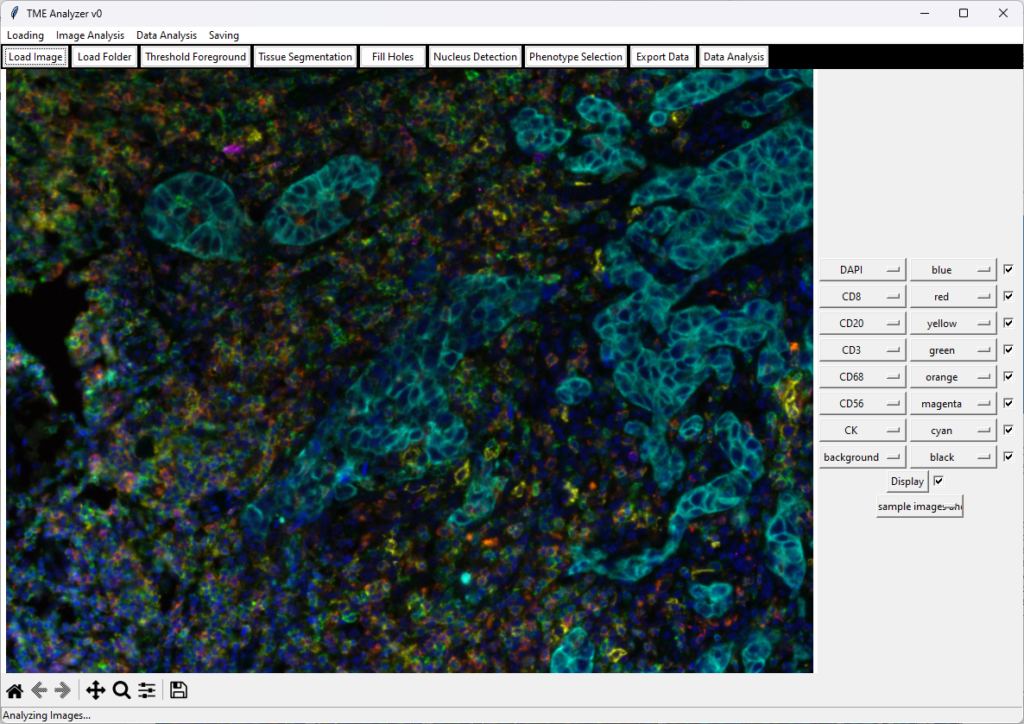Stand-alone software | Tutorial | Publication | GitHub repository | Developer
A novel multi-dimensional visualization and analysis tool to interrogate immune micro-environments of tumors
Spatial architecture of the tumor microenvironment (TME), particularly in relation to numbers, subsets, locations and distances among immune cell populations, as well as their changes in time, are critical in understanding tumor evolution and response to therapy. The prognostic value of the immune contexture of the TME is best captured when multiple parameters are combined and inter-related, superseding the mere expression of single markers. To enable the search for contexture-based predictors, it is imperative to interactively visualize and interrogate immune micro-environments of tumors. To enable multi-parameter studies of the spatial architecture of the TME, novel multiplexed microscopy methods have been developed, such as those that make use of either repetitive staining and imaging, spectral deconvolution of overlapping fluorophores or mass cytometry coupled to ablation of tissues.
As different techniques have become widely available and complexity of images have significantly increased, consistent and user-friendly analysis of such data, and its relationship to clinical outcomes, have become more and more challenging. To address shortcomings in multiplex image analysis, I have developed TME-Analyzer: a python-based what-you-see-is-what-you-get (WYSIWYG) interactive graphical user interface (GUI) software. TME-Analyzer is a newly developed and guided-user interface with the unique option to gate according to cell characteristics and expression markers for quick and reproducible image and data analysis. TME-Analyzer is compatible with fluorescent and other high-dimensional images that have a nuclear marker for cell detection, and comes with integrated quantification of cellular and tissue phenotypes, their densities in defined compartments and their interspacing, as well as visualization and exportation of data. This tool has been so far utilized in analysis of various cancer types (e.g. early-stage ora cavity cancer, nasopharyngeal carcinoma, colorectal cancer, metastatic urothelial cancer, triple-negative breast cancer, prostate cancer, melanoma, etc.), and platforms (multiplexed immune fluorescence, multiplexed ion beam imaging by time of flight, immune histochemistry of in-situ hybridization).

The software has been made available together with its publication in npj Imaging:
- Hayri E Balcioglu, Rebecca Wijers, Marcel Smid, Dora Hammerl, Anita M Trapman-Jansen, Astrid Oostvogels, Mieke Timmermans, John WM Martens and Reno Debets. TME-Analyzer: a new interactive and dynamic image analysis tool that identified immune cell distances as predictors for survival of triple negative breast cancer patients. npj Imaging.
In this publication, we benchmarked TME-Analyzer against 2 software tools regarding densities and networks of immune effector cells using multiplexed immune-fluorescent images of triple negative breast cancer (TNBC). With the TME-Analyzer we identified a 10-parameter classifier in triple-negative breast cancer. This classifier predominantly featured cellular distances, andsignificantly predicted overall survival. This was validated using multiplexed ion beam time of flight images from an independent cohort. Ultimately, the TME-Analyzer enabled accurate interactive analysis of the spatial immune phenotype from different imaging platforms as well as enhanced utility and aided the discovery of contextual predictors towards the survival of TNBC patients.